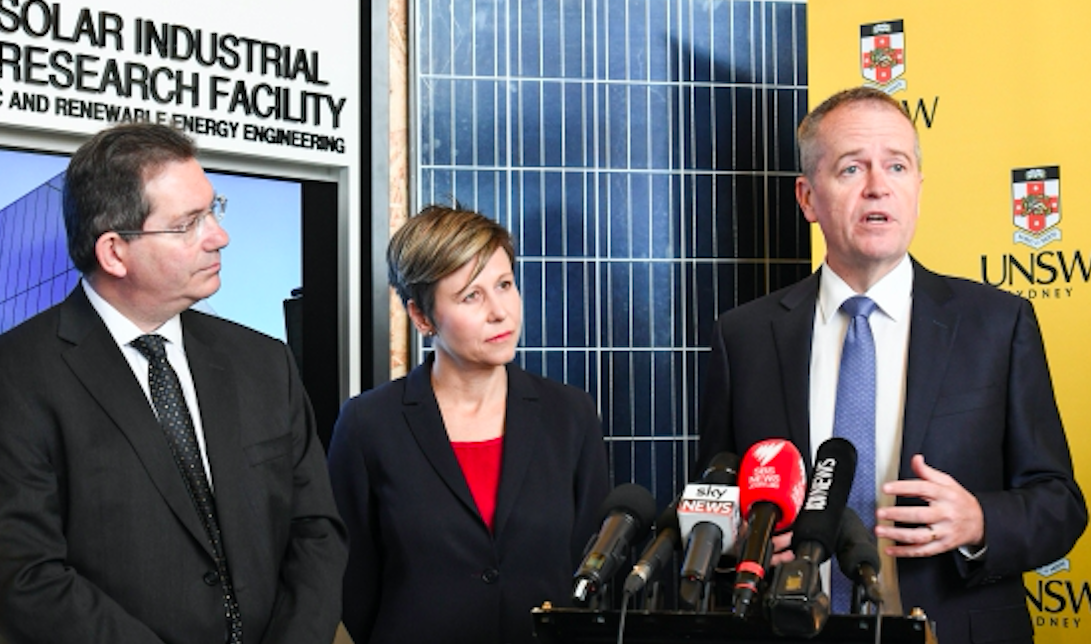While visiting one the world’s leading solar research institutes, Federal Opposition Leader Bill Shorten praised the UNSW’s “remarkable” PV work, its 100% renewable procurement plan, and called for the states and Commonwealth Government to take an “old fashioned” approach to the NEG negotiations.
“We haven’t given up on hoping that the states and Federal Government can resolve the system,” said Shorten at a press conference at UNSW. “We don’t think that the proposal of the Government is all bad.
“I think what we need to see is a fair dinkum negotiation on Friday. You know, what’s wrong with the old fashioned approach which gets all the points of view in the same room and you come to a meeting of minds?
“What I don’t want to hear is that Mr Turnbull says one thing to the states on Friday and another thing to his party room next Tuesday. The States are coming up with reasonable questions. I think what we need to do is see the legislation.”
Drawing on these comments and other sources presumably inside federal Labor, the Australian Financial Review reports that Shorten will push for Labor states like Queensland and Victoria to reach some kind of agreement with Federal Energy and Environment Minister Josh Frydenburg at the COAG Energy Ministers’ meeting tomorrow.
The AFR reports that if the 26%-by-2030 emissions reduction target is to be legislated by the Federal Parliament, as Frydenburg is proposing, Labor will try to install a higher target as the legislation makes its way through the Senate. This will be no easy task, but with Labor and the Greens support – assuming the latter can be convinced of the strategy – there is a chance it might work.
“There are concerns being expressed [about the NEG as proposed], not just by me but by experts, that the current policy settings of the Federal Government will strangle renewable energy and therefore deny Australians access to cheaper energy,” said Shorten.
Bill Shorten, along with Labor NSW Senator Jenny McAllister toured the UNSW’s Solar Industrial Research Facility (SIRF). The facility plays a key role in translating the university’s fundamental work on crystalline silicon PV cells into commercial processes. This includes the UNSW’s pioneering work into advanced hydrogenation, continuing the work of Stuart Wenham.
Alongside addressing tomorrow’s NEG negotiations, Shorten praised the role of the UNSW in the solar industry.
“Some of the remarkable things we’re seeing researched here – it means that solar rooftop is about a third of the normal electricity grid price that people are paying now,” said Shorten. “That is what solar can do.”
This content is protected by copyright and may not be reused. If you want to cooperate with us and would like to reuse some of our content, please contact: editors@pv-magazine.com.









By submitting this form you agree to pv magazine using your data for the purposes of publishing your comment.
Your personal data will only be disclosed or otherwise transmitted to third parties for the purposes of spam filtering or if this is necessary for technical maintenance of the website. Any other transfer to third parties will not take place unless this is justified on the basis of applicable data protection regulations or if pv magazine is legally obliged to do so.
You may revoke this consent at any time with effect for the future, in which case your personal data will be deleted immediately. Otherwise, your data will be deleted if pv magazine has processed your request or the purpose of data storage is fulfilled.
Further information on data privacy can be found in our Data Protection Policy.